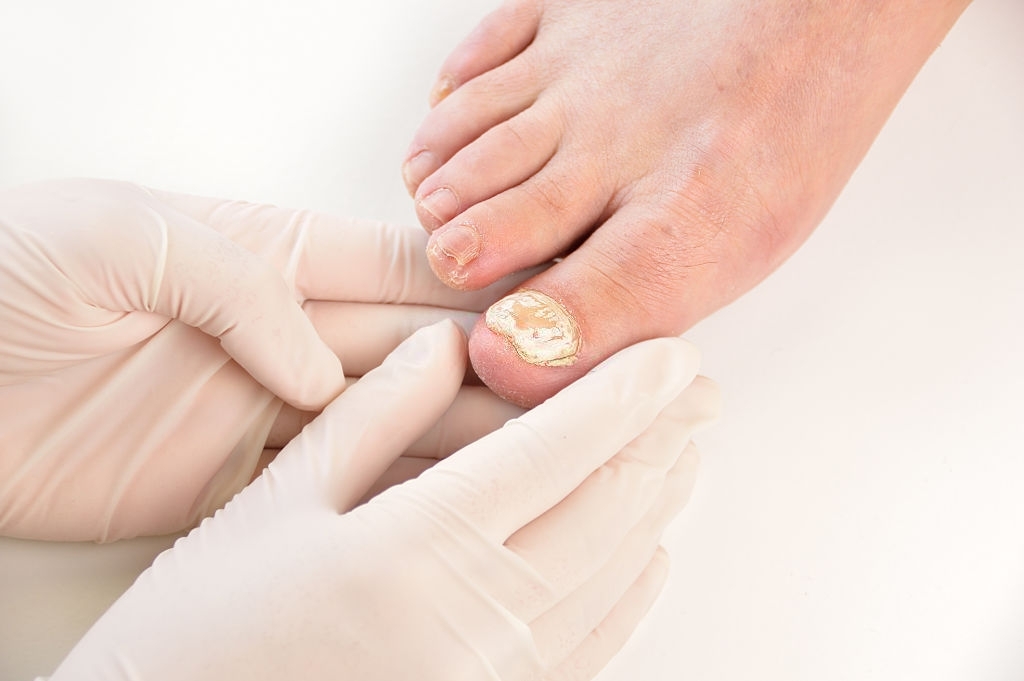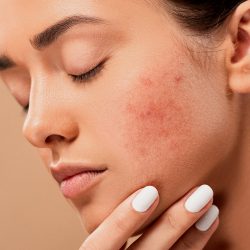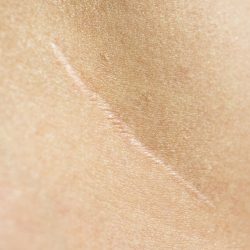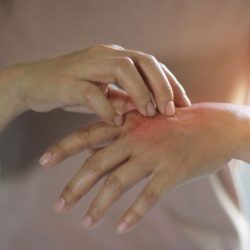Dermatophytes, which cause mycosis, are ubiquitous filamentous fungi belonging to the genera Microsporum, Trichophyton and Epidermophyton. Well adapted to parasitic life, they have a strong affinity for keratin and cause various skin lesions in humans and animals known as dermatophytoses or dermatophyties.
Dermatophytoses are the most common skin mycoses in humans. They cause superficial lesions on hairless skin, the palms and soles of the feet, folds (intertrigos), hair or body hair (folliculitis, kerionitis), as well as nail lesions (onyxis). Dermatophytoses are generally benign in immunocompetent individuals, and often develop in a chronic and frequently recurrent fashion.
Lesions on hairless skin
Dermatophytoses, which are common in consultations, are superficial mycoses caused by filamentous fungi of three genera: Epidermophyton, Microsporum and Trichophyton. These dermatophytes have an affinity for keratin, affecting the epidermis, hair and nails, and are always pathogenic. They never affect mucous membranes.
Transmission occurs through contact with contaminated hair or scales. The main sources of infection are varied. Human-to-human contact often transmits the infection (e.g. Trichophyton rubrum). Animal-to-human transmission is also common (e.g. Microsporum canis). And soil to human (geophilic species).
In epidemiology, Trichophyton rubrum causes 70-80% of dermatophytosis of the folds. Trichophyton interdigitale follows with 15-20%. Epidermophyton floccosum accounts for 5%. Dermatophytosis of hairless skin often comes from the feet. Or from animal sources such as cats or dogs (M. canis). Contact may be direct or indirect.
Circuminous herpes
Circular herpes is a fungal infection of the face, trunk and limbs, manifested by pink to red annular patches with scaly edges. It is caused by a fungus of the genus Trichophyton, which produces circular patches with a red edge that spread rapidly. This infection, which is different from viral herpes, is a form of dermatophytosis.
It is often contracted through contact with domestic animals such as dogs and cats. Circine herpes can also be transmitted between humans or, more rarely, via contaminated soil. Typical symptoms include circular red lesions.
Circular herpes is sometimes called “St Catherine’s wheel” for its characteristic circular shape. It can be treated with antifungal medication. Infection can occur in a number of ways: zoophilic (through animals), anthropophilic (between humans) or geophilic (through soil).
Symptoms appear as red, scaly patches, often accompanied by itching. Diagnosis is usually made by clinical examination, sometimes supplemented by a Wood’s lamp or samples taken for analysis.
For treatment, antifungal creams, sometimes combined with corticosteroids, are prescribed. In the case of multiple or severe lesions, oral treatment may be necessary.
Preventing recurrences involves good hygiene: careful drying, personal use of towels, wearing suitable footwear and regular disinfection of shoes. For infants, gentle cleaning and thorough drying of the buttocks are crucial to preventing diaper rash.
Intertrigo
Intertrigo is an infection of the skin folds. It often occurs as a result of excessive moisture. Inadequate hygiene or excess weight can also cause it. It usually develops under the breasts, between the skin folds. It can also be found between the toes, in the armpits, under the buttocks and in the groin. Symptoms include red patches bordered by small pustules. These pustules may later form scabs. It can also affect the folds between the toes (athlete’s foot) or in the groin (Hebra’s margin eczema).
This skin condition is linked to inflammation of the skin in the folds due to a constantly damp, poorly ventilated environment with little exposure to light. Friction or scratching lesions in response to itching often aggravate the inflammation. Intertrigo is closely associated with obesity and has been linked to diabetes in the elderly.
The areas most commonly affected by intertrigo are the folds under the breasts, armpits, groin, between the buttocks, genitals, between the toes, corners of the mouth and skin folds in obese people.
Intertrigo can be classified as either non-specific (like eczema or psoriasis) or infectious (due to bacterial or fungal colonisation). Inguinal intertrigo, often called “Hebra’s marginal eczema”, causes intense itching between the folds of the legs.
Although very rare, intertrigo can encourage the development of basal cell carcinoma of the genital area or groin, a type of cancer associated with poor hygiene, chronic local skin irritation or a history of radiotherapy.
Trichophytes of the feet (athlete’s foot)
Trichophytitis of the feet, commonly known as athlete’s foot, is a frequently observed dermatophytosis, mainly localised between the toes. The name comes from the fact that people who take part in sporting activities are often affected by this skin condition. The hot, humid environment created by sweating feet in shoes encourages the Trichophyton fungus to proliferate.
The characteristic symptoms of trichophytitis of the feet are cracks in the skin between the toes, scaling of the skin, itching, redness and burning. It is often accompanied by an unpleasant odour. Athlete’s foot, also known as intertrigo inter-torteils (scientific name: tinea pedis), is actually an infection of the skin caused by microscopic fungi, in particular species belonging to the genera Trichophyton, Epidermophyton or Microsporum. This condition mainly affects teenagers and is highly prevalent, affecting around 25% of the population.
In terms of prevention, maintaining good foot hygiene by washing and drying feet properly, particularly between the toes, is of crucial importance. Walk barefoot on clean surfaces or opt for sandals rather than closed shoes. Avoid plastic shoes, preferring leather, and opt for white cotton socks, which help the skin to breathe, as sensible preventive measures. In changing rooms or communal showers, wear beach sandals and don’t share towels, clothes, socks or shoes, as certain fungal infections can be transmitted by contact with these textiles. Maintain these preventive habits even after recovery to avoid recurrences.
Pityriasis versicolor
Pityriasis versicolor is a superficial mycosis caused by a yeast of the genus Malassezia. The condition manifests itself as painless white to brown scaly patches on the trunk, abdomen and sometimes the face. These patches are often accompanied by scaling of the skin. Conditions favouring its development include heat and humidity, particularly in environments such as sweating, saunas and swimming pools.
Malassezia furfur is a fungus that can exist as yeast or mould. It is normally part of the normal skin flora, but in some people it can proliferate and cause pityriasis versicolor. Most people affected are in good health, but certain factors such as heat, humidity, immunosuppression due to corticosteroid therapy, pregnancy, malnutrition and diabetes can predispose to this condition.
Pityriasis versicolor can also be caused by a yeast of the genus Pityrosporum. It is also known as seborrhoeic eczema and can be encouraged by factors such as alcoholism, stress, an unbalanced diet, as well as more serious conditions such as AIDS. This skin infection is characterised by the presence of multiple scaly patches, usually asymptomatic, ranging from white to brown or pink. Treatment involves the use of topical and sometimes oral antifungal agents, although recurrences are common.
Treatment of pityriasis versicolor involves the use of topical and sometimes oralantimycotics. After treatment, recurrences are common due to the commensal nature of the fungus on the skin. Good skin hygiene and regular use of antifungal products can help prevent recurrences. Although pityriasis versicolor can affect immunocompromised people, most cases occur in healthy individuals.
Nail lesions: onyxis or onychomycosis(tinea unguium)
This is the most frequent reason for consultation in dermatological mycology. The lesions mainly affect the toenails. The usual appearance is distolateral onychomycosis affecting the free edge of the nail, forming a yellowish patch which extends towards the matrix. The nail thickens, becomes hard and crumbles from the underside. Other aspects may be observed: superficial leukonychia (the nail is attacked on the surface at the level of the upper tablet), proximal onychomycosis (the nail is attacked at the level of the matrix), total onychomycodystrophy (the nail is totally destroyed).
Onychomycosis accounts for around 50% of nail pathology. Dermatophytes (in particular Trichophyton rubrum and Trichophyton interdigitale) are the main agents isolated from the feet. Yeasts of the Candida genus (Candida albicans, Candida parapsilosis, etc.) predominate on the hands, most often associated with perionyxis. The nails most affected are those on the feet, particularly the big toe.
Removal of the dermatophytes responsible for the infection does not restore the normal shape and colour of the nail, which only returns with gradual nail growth.
In recent years, dermatologists have reported an increase in the number of onychomycoses caused by non-dermatophytic moulds (NDM), although this trend cannot be explained. In these cases, the pathogens are, for example, Scopulariopsis brevicaulis or species of the Fusarium and Aspergillus genera, or other rare moulds.
The treatment of onychomycosis can be complex and varies according to the type of fungus responsible. It may include local treatments, such as antifungal varnishes, as well as systemic treatments, such as oral antifungal medication.
Some people are at greater risk of developing onychomycosis, particularly those with a family history of the disease, blood circulation problems, a weakened immune system, or who engage in activities that encourage contamination by fungi, such as swimming.
Which essential oils should I use?
Certain skin mycoses are common and take a variety of forms depending on the microscopic fungus responsible. When an infection occurs, it can manifest itself by the appearance of red, oozing patches, itching and scaling, disrupting the skin’s balance.
To eliminate these fungi, consider a synergistic approach using four essential oils with antifungal, anti-inflammatory and healing properties. Combine these essences to maximise their effectiveness against fungal infections.
Vegetable oils are commonly used as carriers, making them easy to penetrate the skin. The choice of vegetable oil varies according to factors such as texture, appearance, composition, properties and the individual’s skin type. Black cumin oil is recommended for its antifungal and immunostimulant properties. For those less familiar with the use of vegetable oils, we recommend Hazelnut or Macadamia oils, thanks to their excellent skin penetration and their ability not to make the skin oily.
Manuka essential oil
Manuka essential oil is antifungal against dermatophytosis. It is particularly effective against Trichophyton terrestris, which causes skin mycosis.
Manuka, also known as New Zealand Tea or Red Manuka, is a shrub native to New Zealand. Its Latin name is Leptospermum scoparium, and the part distilled to obtain its essential oil comes from its twigs.
Manuka essential oil should be used with caution. It is not suitable for pregnant or breast-feeding women, women under 3 months pregnant, or children under 6 years of age. The most appropriate method of application is via the skin, while ingestion is reserved for therapeutic use.
As for its composition, Manuka essential oil is highly concentrated in leptospermone, flavesone, trans calamene, alpha copaene and cadin-3,5-diene, which give it its main properties.
It has exceptional antibacterial action, surpassing even Tea Tree essential oil. This essential oil acts effectively against a wide range of bacteria, including Gram – like Staphyloccocus (aureus, epidermidis) and Streptococcus (faecalis, agalactiae), as well as Gram – like Escherichia coli, Pseudomonas aeruginosa, Klebsiella pneumoniae, and many others.
It is effective against many fungi responsible for mycosis, including Candida albicans, Tricophyton rubrum, Aspergillus niger, Microsporum canis and mentagrophytes.
Thanks to its triketones, Manuka essential oil also acts on viruses, offering relief for certain ENT infections.
Manuka essential oil has significant benefits in the treatment of skin mycoses. It acts effectively against the fungi responsible for mycosis, has anti-inflammatory properties to relieve skin irritation, promotes healing of damaged tissue and prevents bacterial infections associated with mycosis.
Coriander essential oil
Coriander essential oil is antifungal on Candida. It is active on athlete’s foot and inter-toe intertrigo (as a topical treatment, prepared at 6% in a vegetable oil). It is used externally on skin mycoses in synergy with palmarosa essential oil.
Coriander, also known by its Latin name Coriandrum sativum L., is an annual herbaceous plant native to Mediterranean countries. It grows to an average height of 30-60 cm. Its leaves and stem are green, sometimes tinged with violet during flowering. The flat, lobed, toothed leaves are most abundant near the root, becoming rarer towards the top of the plant. The flowers are pinkish-white and grouped in flower heads.
The seeds are distilled to obtain Coriander essential oil. This colourless to pale yellow essential oil has a fresh, slightly spicy fragrance with a woody note.
Chemically, Coriander essential oil is mainly composed of linalool (59-87.5%), α-Pinene (0.1-10.5%) and γ-Terpinene (0.1-9.1%). These components give it some interesting properties.
It is known for its digestive tonic, carminative and stomachic properties, making it an effective remedy for bloating and dyspepsia. It also has antibacterial, antiviral, antiparasitic and antifungal properties, making it useful for treating respiratory tract infections and fungal infections.
Coriander essential oil also has anti-inflammatory properties, making it an appropriate choice for relieving pain associated with osteoarthritis, rheumatism and muscle aches. It acts as a brain tonic, antidepressant and euphoric, making it beneficial for combating physical or mental fatigue, provided it is used in low doses.
Lavender Aspic essential oil
Lavender aspic essential oil is fungicidal, and lavender aspic is invaluable for treating skin fungal infections, particularly athlete’s foot.
Spike lavender, also known by its Latin name Lavandula latifolia Medik, is a Mediterranean plant that produces an essential oil with remarkable healing and analgesic properties for the skin. This oil, rich in compounds such as linalool, camphor and 1,8-cineole, offers a variety of health benefits.
Lavender Aspic essential oil is renowned for its local anaesthetic properties and its effectiveness in relieving skin pain and itching, particularly caused by stings, burns or bites. It works by interacting with the nociceptive receptors responsible for the sensation of pain.
What’s more, thanks to the presence of linalool, it has anti-inflammatory properties, reducing inflammation resulting from skin aggressions such as stings and bites.
The camphor contained in the essential oil promotes healing by facilitating the elimination of toxins from damaged areas of the skin. As an antibacterial and antifungal agent, it effectively combats certain fungi and bacteria, including the dreaded Staphylococcus aureus.
To treat athlete’s foot, you can safely apply 1 undiluted drop of Lavender Aspic to the affected area, 2 or 3 times a day, for people over the age of 6. In the case of extensive mycosis, we recommend diluting it in a vegetable oil. Be sure to take a break for a week after 3 weeks’ use.
However, although Lavender Aspic is effective against fungal infections, it should be noted that Tea Tree essential oil is often preferred for treating this type of skin problem.
Lemon Eucalyptus essential oil
Lemon Eucalyptus essential oil is antifungal. It is very useful for skin mycoses, athlete’s foot, onyxis and peri onyxis.
Lemon Eucalyptus, also known by its Latin name Eucalyptus citriodora Hook. or Corymbia citriodora Hook. is a large tree native to Australia, growing up to 60 metres tall.
- Effective antifungal (citronellol, citronellal): It actively combats fungi, including Candida albicans, as well as certain dermatophytes responsible for nail fungus (onyxis and perionyxis). Studies have shown it to be effective against various fungi that are pathogenic to plants.
- Analgesic (citronellal): It relieves skin and joint pain. This makes it an ideal choice for alleviating the itching and discomfort associated with fungal infections.
In the case of athlete’s foot, Lemon Eucalyptus essential oil can be safely applied. Simply dilute one undiluted drop on the affected area, 2 or 3 times a day, for people over the age of 6.
Tea Tree essential oil
A true essence with a thousand and one virtues, tea tree essential oil is a precious ally in the treatment of athlete’s foot (interdigital mycosis caused by dermatophytes). It is an antifungal agent against Candida sp. and is an important ally in combination with imidazole antifungals in cases of resistance.
Its main characteristics include :
- Broad-spectrum antifungal (terpinene-4-ol, γ-terpinene, α-terpinene): Tea Tree’s active compounds have the ability to alter the membrane of fungi responsible for mycosis. It inhibits their metabolism and proliferation. The fungi targeted include Candida albicans, Malassezia furfur and others responsible for various forms of mycosis.
- Broad-spectrum antibacterial (terpinene-4-ol): Tea Tree is also effective against a wide range of bacteria, including Escherichia coli and Staphylococcus aureus, which can be associated with infections.
- Antiviral (terpinene-4-ol, γ-terpinene, α-terpinene): Its components act against enveloped viruses, such as Herpes simplex. It disrupts their shell and destroys them.
- Antiprotozoal and antiparasitic (terpinene-4-ol, γ-terpinene, α-terpinene): Tea Tree essential oil penetrates parasite cells. It alters their membranes and internal components. It also limits the development of intestinal parasite larvae.
When it comes to treating fungal infections, Tea Tree essential oil offers a simple, effective approach. For adults and children over the age of 6, apply one pure drop of Tea Tree directly to the affected area, morning and evening, after thorough cleansing. After 3 weeks of continuous use, take a break for a week. In the case of extensive mycosis or prolonged use, it is preferable to dilute it in a vegetable oil.
Tea Tree essential oil works by disrupting the membrane of fungi, slowing down their metabolism and boosting the body’s immune response by producing immunoglobins. It is particularly effective against various forms of fungal infections, including those of the nails, feet and other skin conditions.
Palmarosa essential oil
Antifungal, Palmarosa essential oil is effective in treating dermatophytes. Its activity is superior to that of certain reference antifungals. It is used for skin mycoses and onychomycosis.
Palmarosa essential oil excels against mycoses and fungi. It has powerful antifungal properties. Geraniol, its main component, acts effectively on many fungi. This includes those that cause fungal infections of the nails, skin and feet. Scientific research confirms its action on dermatophytes. These are responsible for most skin mycoses. It is also effective against other fungi, such as Candida albicans and Malassezia Pachydermatis.
In addition to its antifungal properties, Palmarosa essential oil also has antibacterial properties that are effective against bacteria such as Escherichia Coli and those responsible for unpleasant perspiration odours. It is also recognised for its spasmolytic and anti-inflammatory effects, improving immune response and intestinal health.
Due to its high geraniol content, Palmarosa essential oil can irritate and sensitise the skin. We therefore recommend using it diluted on the skin. To treat fungal infections, from the age of 6, mix a drop of this oil with a vegetable oil, such as Neem or Nigella, before applying to the affected area. This method is effective for fungal infections of the skin, nails or feet.
Mycosis is caused by the excessive proliferation of microscopic fungi. They can affect various parts of the body, including mucous membranes, and often develop in damp environments. Although generally not serious, they can be contagious, sometimes requiring medical attention for persistent or recurrent fungal infections.





